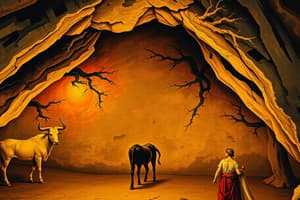Podcast
Questions and Answers
What is the Great Hall of Bulls?
What is the Great Hall of Bulls?
Left wall of the Hall of Bulls, Lascaux II (replica of the original cave, which is closed to the public). Original cave: c. 16,000-14,000 B.C.E., 11 feet 6 inches long.
How were the animals rendered in the Great Hall of Bulls?
How were the animals rendered in the Great Hall of Bulls?
In twisted perspective, with their bodies depicted in profile and horns seen from a frontal viewpoint.
What does the large scale of many animal images suggest about the artists?
What does the large scale of many animal images suggest about the artists?
They worked deliberately, carefully plotting out a form before completing outlines and adding color.
What might be the significance of the repetitive drawing and re-drawing in the 'rooms' of the Great Hall?
What might be the significance of the repetitive drawing and re-drawing in the 'rooms' of the Great Hall?
What theory did Breuil propose about the purpose of the images in the cave?
What theory did Breuil propose about the purpose of the images in the cave?
What narrative elements can be observed in the images of Lascaux?
What narrative elements can be observed in the images of Lascaux?
What is the mystery surrounding the bird-headed figure in the artwork?
What is the mystery surrounding the bird-headed figure in the artwork?
What is one certainty about the artwork of Lascaux?
What is one certainty about the artwork of Lascaux?
Flashcards are hidden until you start studying
Study Notes
Great Hall of Bulls Overview
- Located in Lascaux II, a replica cave, the Great Hall of Bulls originally dates back to approximately 16,000-14,000 B.C.E.
- The hall itself measures 11 feet 6 inches in length.
Artistic Techniques
- Animals are depicted using "twisted perspective," showcasing their bodies in profile while presenting horns from a frontal view.
- Some images are drawn entirely as contour lines to define the animals.
Artistic Process
- Large-scale animal images suggest deliberate planning by artists, who likely sketched outlines before adding color.
- It is believed that skilled "master" artists collaborated with assistants to mix pigments and provide lighting with animal fat lamps.
Engraved Forms
- In areas dominated by engravings and overlapping designs, the drawing process may have held significant ritualistic meaning for the creators.
Purpose of Imagery
- André Breuil theorized that the images were part of "hunting magic" rituals intended to ensure successful hunts by symbolically overpowering prey.
- Another theory posits that these images serve as narratives; specific depictions tell stories, such as the dynamic illustration of a bison with a bird-headed humanoid figure.
Narrative Interpretations
- The bison image conveys a sense of action, suggesting it has been wounded, possibly by a weapon or the horn of a nearby rhinoceros.
- Adjacent elements, including a bird-headed human and an arrow with barbs, contribute to an interactive scene among the figures.
Mystical Elements
- The depiction of a humanoid figure with a bird head raises questions about its significance, with hypotheses suggesting it represents a shaman or spiritual communicator.
Legacy of Lascaux
- The Great Hall of Bulls exemplifies the enduring human desire to express and communicate through visual storytelling, highlighting the complexities of prehistoric artistic endeavors.
Studying That Suits You
Use AI to generate personalized quizzes and flashcards to suit your learning preferences.





